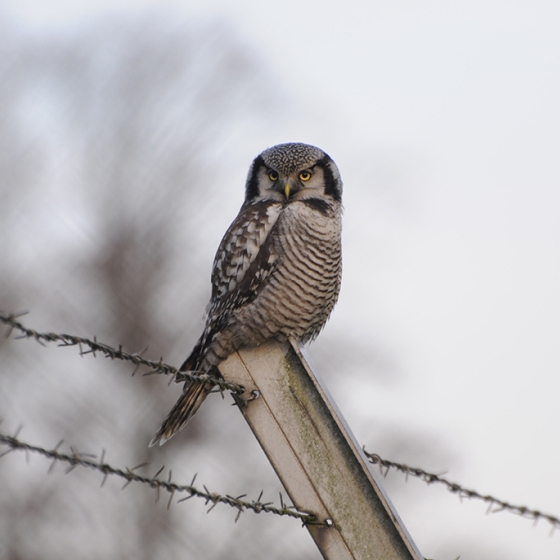Hawk Owl

Introduction
Unusually for an owl, this species is primarily diurnal in habits and is often seen perched on the very tops of trees. Hawk Owl is an extremely rare visitor from northern Europe.

Key Stats
Status and Trends
Conservation Status
Population Size
Population Change
Population trends of this scarce species are not routinely monitored.
Distribution
This vagrant has not been recorded in the UK for many decades and as such cannot be mapped.
European Distribution Map
Distribution Change
This vagrant is too rarely reported to map distribution change.
Seasonality
This species has been too rarely reported to BirdTrack during 2011–22 to properly assess seasonality.
Movement
Britain & Ireland movement
European movements
EuroBirdPortal uses birdwatcher's records, such as those logged in BirdTrack to map the flows of birds as they arrive and depart Europe. See maps for this species here.
The Eurasian-African Migration Atlas shows movements of individual birds ringed or recovered in Europe. See maps for this species here.
Biology
Survival and Longevity
Survival is shown as the proportion of birds surviving from one year to the next and is derived from bird ringing data. It can also be used to estimate how long birds typically live.
Classification, names and codes
Classification and Codes
- Order: Strigiformes
- Family: Strigidae
- Scientific name: Surnia ulula
- Authority: Linnaeus, 1758
- BTO 5-letter code: HAWOW
- Euring code number: 7500
Alternate species names
- Catalan: mussol esparverenc
- Czech: sovice krahujová
- Danish: Høgeugle
- Dutch: Sperweruil
- Estonian: vöötkakk
- Finnish: hiiripöllö
- French: Épervière boréale
- German: Sperbereule
- Hungarian: karvalybagoly
- Icelandic: Haukugla
- Italian: Ulula
- Latvian: svitraina puce
- Lithuanian: raiboji peleda
- Norwegian: Haukugle
- Polish: sowa jarzebata
- Portuguese: mocho-rabilongo
- Slovak: krahula hôrna
- Slovenian: skobcja sova
- Spanish: Cárabo gavilán
- Swedish: hökuggla

